‘Out of the Furnace’—the Movie, the Cultural Phenomenon
- Like
- Digg
- Del
- Tumblr
- VKontakte
- Buffer
- Love This
- Odnoklassniki
- Meneame
- Blogger
- Amazon
- Yahoo Mail
- Gmail
- AOL
- Newsvine
- HackerNews
- Evernote
- MySpace
- Mail.ru
- Viadeo
- Line
- Comments
- Yummly
- SMS
- Viber
- Telegram
- Subscribe
- Skype
- Facebook Messenger
- Kakao
- LiveJournal
- Yammer
- Edgar
- Fintel
- Mix
- Instapaper
- Copy Link
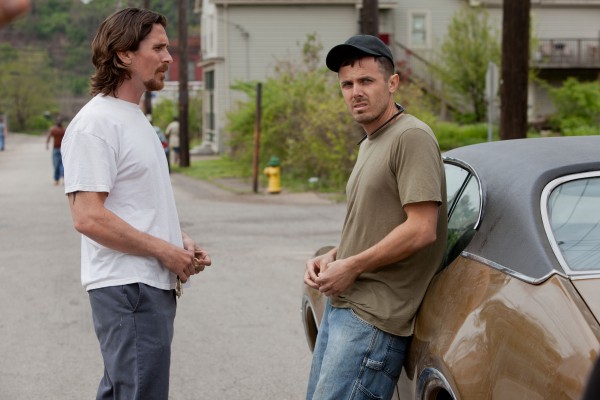
Although Christian Bale (L.) has received praise for his performance as Russell Baze, many consider Casey Affleck’s (R.) work as the troubled and erratic Rodney to be the best in the film.
It’s the movie that launched a thousand opinions. Out of the Furnace has provoked such a range of reactions, both nationally and locally, that the buzz wars have come close to upstaging the movie itself. Is it a Best Picture candidate that offers a rare kind of cinematic storytelling or just a conventional story kept afloat by an all-star cast? Is it a deeply moving new epic in the spirit of The Deer Hunter or just too slow-moving?
There has been much debate, too, about the social-commentary aspects of Out of the Furnace. One issue is how authentically it portrays (or to what extent it “mythologizes”) blue-collar life. Another is its use of violence—or as a reader’s post on The New York Times website put it, the use of “violence as a metaphor for America.” Such issues are magnified locally, since Furnace is the latest of many works, in various media, that have used Braddock to speak for the post-industrial predicament in America.
What I would like to try here is more than another review of the movie. Let’s look at the whole phenomenon—in a way, I hope, that might help illuminate the big picture whether you’ve already seen the film, plan to see it, or wouldn’t consider it.
I can speak to some aspects from a personal viewpoint, being a native of the area in which most of the movie was filmed and the action is explicitly placed. Born in Braddock, I lived most years through my teens on the uphill side of the railroad tracks in North Braddock, where the steelworker’s home is located in Furnace. I remain close to people in the two towns which, along with neighboring Rankin, make up the now-fabled 15104 zip code. (In case you didn’t know why it is “fabled”: This area a few miles east of Pittsburgh was once a booming mini-metropolis. Andrew Carnegie’s first steel mill, opened in 1875, is here and has kept running, but the towns eventually went into severe depopulation and decline; they’re now in early rebirth mode).
But aside from the Braddock angle, let’s also look at the quality of the movie in moviegoer terms. For me, in a nutshell, Out of the Furnace was neither a two-thumbs-upper nor a downer, nor anything in between on the love-it-or-shove-it scale. I’d put it in a different category entirely.
It is an interesting movie. The characters caught my emotional interest; I cared about them. And the movie is interesting to watch and think about, if you want to think about how movies work—and how we respond to them—generally. Here we go.
The Story, the Authenticity Factor
Basic story line: Steelworker Russell Baze (Christian Bale) and his younger brother Rodney (Casey Affleck) are good-natured but hard-luck guys in a decayed mill town. Rodney, an Iraq veteran, can’t fit into the workaday routine back home. To make money he turns to an illicit sport: bare-knuckle fighting in savage matches staged for savage crowds of gamblers. This is bad company. Rodney dies, not in a match but in a gangland hit orchestrated by vicious crime boss Harlan DeGroat (Woody Harrelson). When the cops fail to get DeGroat, Russell sets out to do the job.
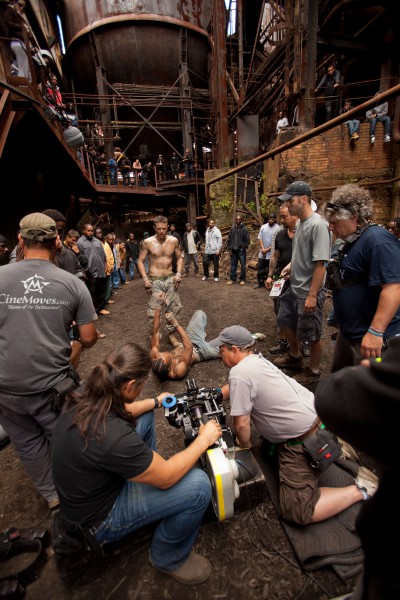
Filming at Carrie Furnaces: the setting is awesome. And Rodney Baze (center) is having a good fight.
A lot more happens along the way, including subplots that stem from Russell’s early attempts to keep Rodney out of trouble. But essentially this a hard-times story that leads to a hard fall, with Russell the rescuer at last embarking on a vigilante redeemer mission.
Authenticity check? To begin with, few steelworkers today still live in the old mill towns, as Russell does. They were moving to the suburbs decades ago (which would play a big part in the very decline of the towns). Some did stay put, though—my dad, who worked in the U.S. Steel railroad yards, never suburbanized—so, while uncommon, it’s plausible to have the Baze brothers there.

There are few women in the film. Zoe Saldana plays the only significant female role as Lena Taylor, the woman involved with Russell; the course of her relationship becomes a major subplot.
Besides, much of the movie’s atmosphere would be lost if, say, those bloody bare-knuckle matches were filmed at the mall. As it is, we see Rodney battling in the dirt, ringed by a cheering mob, at the foot of the abandoned Carrie Furnaces. If you go to the film in part to see what it does with local landmarks, these massive old blast furnaces towering above an empty plain are used to stunning effect in more than one scene.
Here, however, a major reality issue arises. To my knowledge, unlicensed bare-knuckle fighting has never been a money sport in the Braddock area. Back in the day, I certainly saw prearranged fights, between young men who either had a personal beef or just wanted to see who could whup whom (and they probably still happen). There were onlookers, and surely, some wagers were placed. But this kind of fighting on an organized scale, run for profit by crooked ringmasters? I don’t think so.
Which leads to the question behind that question: If the central bare-knuckle gimmick is an invention, does it make the whole movie bogus? Not necessarily.
I know a Vietnam veteran who says The Deer Hunter is truer to his experience of that war than any other movie—even though a central device is pure fiction. American POWs were not forced by their captors to play Russian roulette, nor were there Russian-roulette matches run for profit by criminal ringmasters in Saigon. Yet my friend insists Deer Hunter is both a good movie and an “authentic” one, spot-on in some other details and powerfully rendering, overall, what life in that wartime was like. Apparently, millions agree. Fiction can be truer than facts. Fiction can use tools such as metaphor, allusion, and symbolic invention to cut through the clutter of everyday-ness and vividly bring out what some facet of life is “like.”
But it’s still fiction. And the real-life people who are being represented may take umbrage at it. When The Deer Hunter was released, after the war, plenty of Vietnamese were upset about the Russian roulette scenes. Out of the Furnace has offended the Ramapough Mountain Indians of New Jersey, who are depicted in the movie as a wild bunch whose members include the villain DeGroat and his gang. The film even has drawn objections from some Braddock residents and blue-collar people nationwide over details that are hair-splitting—such as, literally, hair. People are irked by the gritty, greasy look sported by Christian Bale and other actors. The objection: We wash our hair, you know.
For an audience, drawing inferences from fiction is complicated. A movie may give you an authentic experience but it operates in a Twilight Zone where the rules are bent. If there’s a simple way through, it might be simply to remember that you are not in Braddock or New Jersey, you’re in the Twilight Zone.
Great Balls of Fire
Out of the Furnace is not your typical violent film. It has no blazing gunfights, no high-speed demolition derbies, no billowing orange fireballs. In movies filled with those things, violence is adrenaline, pumped out to suck in audiences.
The violence in Out of the Furnace is personal. The beatings, shootings, and bullyings register as violence does in real life (bad for people), and though the movie doesn’t race constantly from one head-banging to the next, the violence is chronic and recurring. As presented here, violence is a sort of cultural virus. Some people have frequent flare-ups and some hardly ever, but the infection keeps going around and coming around.
It seemed to me that the movie tries to catalogue all the kinds of violence humans are capable of. Along with guys beating on guys, various scenes include: Rodney describing the horrors he witnessed in Iraq, a child killed in a DUI accident, an animal hunted down and shot (in another conscious parallel to The Deer Hunter), an incident of prison violence, and one of violence against a woman. If you have wondered what a vicious crime boss is like on a date, the opening scene shows you. DeGroat’s character is established when he grabs the hot dog his date is about to eat, takes the giant wiener from the bun, and shoves it down her throat whole.
And what are the moviemakers trying to tell us with this cinematic overview of violence in our time? What does that say about the moviemakers? About us? These are good questions. Probably more interesting questions than ooh, did you see that fireball?
Bests and Worsts
What I liked best about Out of the Furnace were the exchanges between characters. The script has lots of little face-to-face encounters in which people are trying to feel each other out, get something or resolve something, and a number of these scenes are quite good: they’re two-minute (more or less) mini-dramas within the larger story.
One is a brief exchange in which good guy Russell meets the bad guy, DeGroat, for the first time. It’s a chance meeting in a bar. DeGroat is walking out of private room when he sees Russell waiting to enter, which looks like eavesdropping, so he fires off a mind-your-own-beeswax insult. Chafed but curious, Russell asks if DeGroat has a problem with him. DeGroat’s glowering exit line is, “I got a problem with everybody.”
That’s a short line that says a lot, and Harrelson gives it the full spectrum of meanings, from “Don’t mess with me” to “Alas, I am a psychopath, incapable of forming healthy relationships.”

Harlan DeGroat (Woody Harrelson, left) has a problem. Russell Baze (Christian Bale) wants to hear it. Despite this touching concern, bromance is not in the cards, and the repercussions that follow raise some interesting questions for the audience.
Other exchanges run longer, and they don’t consist only of cleverly scripted zingers. The best ones are full of hesitations and twists and turns that make them feel real. A nice example is a scene played brilliantly by Pittsburgh actor Jack Erdie. He’s a drug dealer at the center of a touchy deal—the kind in which the buyer and seller don’t know each other, and nobody is sure who will do what. Erdie delivers the goods in every sense of the word. Casey Affleck, as Rodney, has several great exchanges, groping his way uncertainly through one confrontation, going off on an unexpected (and touching) tangent in another.
There are so many of these vignettes—interspersed with bursts of violence that seal somebody’s fate or move the plot along—that one can see why some viewers complain the movie is too slow. And Furnace does have an odd-duck structure. It’s neither a brisk action movie nor an introspective character-study film. It sort of tries to be both, with a series of little nuggets of character exchange strung around an admittedly conventional action/revenge plot.
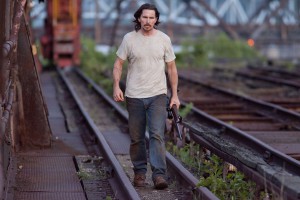
In the vein of many past movie heroes, Russell is portrayed as a gentle, even-tempered man who is nonetheless drawn into strife.
My suggestion, with this film or any other: Just go with what the movie is trying to do. Don’t fight it, let it wash over you, and see what sticks. I think a lot of these nuggets will, in Out of the Furnace.
One of the weakest aspects of Furnace is that it’s a low-voice film. A precept of film acting says you should not try to project your voice as you would on stage but speak in natural tones. This has been carried so far in movies recently that hoarse whisper-itis is rampant across the industry. In the worst cases, Brando-style mumbling makes it hard to even tell what is being said. (Did you see Lars von Trier’s Melancholia? Good, because I’ll bet you didn’t hear it.)
Out of the Furnace isn’t a worst case; the words are intelligible. But much of the time, the characters talk in tones and levels more suited to the confessional or the library. That effect can make the movie feel “slower” than it actually is.
It also struck me as the most inauthentic aspect of the film in terms of capturing what life in a blue-collar town is like. At one point I felt like calling out, “Hey! Don’t you know there are times when people around here TALK LOUD?” I even worried that the film was conveying a stereotype of the oppressed masses ground down to a state where they can speak only in hushed tones, which isn’t how any masses of my acquaintance roll.
What Furnace could have used more of is not action, but exuberance. Maybe a happy, celebratory scene—like the wedding party in The Deer Hunter—or how about this: a funny scene. The Law of Narrative Karma, which applies to books and plays as well as movies, states that tragedy is most tragic when there is also some comedy.
How Good Is The Bad Guy?
In some of the laudatory buzz, Woody Harrelson’s Harlan DeGroat is being touted as the most memorable movie villain in many a year. That’s debatable, as there have been several worthy contenders for the title. One is the villain who killed Harrelson in No Country for Old Men, the freelance outlaw Anton Chigurh, played by Javier Bardem.
I don’t care to try and rank who is the “best” bad guy; Chigurh and DeGroat and some others are all good and creepy. What’s more interesting is to note that they are different
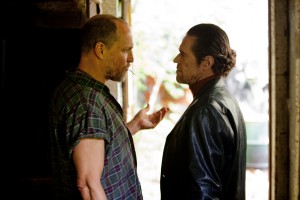
Willem Dafoe (R) plays John Petty, a local wheeler and dealer whose entanglement with out-of-town big wheel DeGroat brings everybody, including himself, into the orbit of big trouble.
kinds of bad guys. Chigurh, for instance, philosophizes while he kills and terrorizes. Before shooting Harrelson’s character—who has tracked down the outlaw, only to walk into a fatal trap—Chigurh says: “Let me ask you something. If the rule that you followed brought you to this, of what use was the rule?”
Chigurh is like a Zen master turned bad, the insidiously keen-witted and intrepid face of evil. Harrelson’s DeGroat is no dummy, but he has no use for philosophizing either. The criminal mind on display here is more of a one-track steamroller mind: I want my money and I want my kicks, now. And I’m going to flatten anyone in my way.
Maybe Chigurh’s evil mind is more subtle and fascinating. But if you want to get into metaphors and social commentary, maybe the DeGroat mind is more reflective of the mindset that actually causes the most grief in our society—or any other.
This Is Reality; That’s Entertainment
So, is Out of the Furnace an entertaining movie? Depends on how you define that. As a number of Braddock residents have noted, it’s not exactly the feel-good movie of the year.
Which is one reason some people in 15104 land have had mixed feelings about it, aside from any opinions on its artistic merits. The publicity the Braddock area has gotten—not only from this movie, but all of it—invites mixed feelings. On the one hand, the publicity is a blessing. It draws attention, new people, and investment. Many times, especially in news-feature pieces, the publicity spreads the word about revitalization efforts and rebirth movements. Altogether, Braddock is getting more publicity now than at the height of its flourishing; the town has achieved celebrity status.
The catch is the two-edged-sword nature of the celebrity status. As an old friend put it, “We’re the go-to poster child for everything that’s gone wrong.” And Out of the Furnace is a kind of film that can come across as another poster on that wall. Perhaps it is asking too much of Hollywood to make movies about the high drama of urban farming or the thrills of new townhouses under construction. Therefore let me recommend the following.
If you are not from 15104 and you really want to know what life is like there, don’t count on a movie. Go find out. (And see the end of this article for a couple of suggestions).
But if it’s movie entertainment you seek, Out of the Furnace evokes thoughts and feelings that other movies may not. Don’t bother to rank it or check its latest score on the
Tomatometer; just check it out and see what you think.
Or, if you enjoy comparisons, try this. Watch The Deer Hunter. Then watch Out of the Furnace (or vice versa). Not to judge which is better, but to see how two different movies, made in different times, deal with similar themes and memes. I promise the taste test will give you food for thought. And it won’t be junk food.
Extra Credits
Out of the Furnace was directed by Scott Cooper and has won this year’s Rome Film Festival award for Best Debut or Second Film by a director. (It is Cooper’s second, after Crazy Heart). Other prominent cast members are Willem Dafoe, Zoë Saldaña, Sam Shepard, and Forest Whitaker. Pittsburgh actor Bingo O’Malley plays Rodney Baze Sr., the brothers’ dying father, in a brief sickbed scene. Many more people from the area appear in the movie or assisted with it.
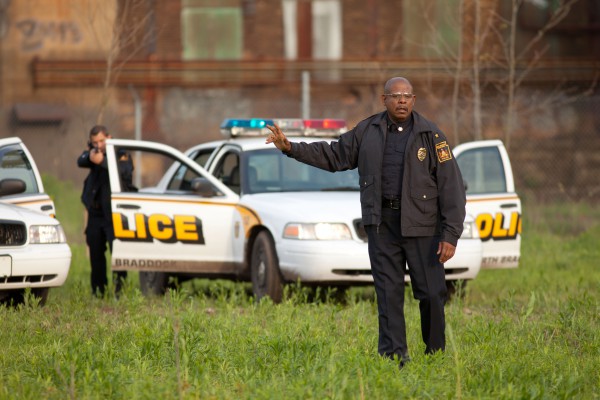
Hold your fire! In the movie’s closing sequence, police chief Wesley Barnes (Forest Whitaker) makes a fateful decision.
And, if you’d like to visit Braddock, there are interesting places, activities, and special events everywhere across town. No master list of events and activities currently exists on a website, but a good starting point is right in the heart of town, where the historic Braddock Carnegie Library and the new Braddock Community Cafe and community center stand face-to-face across the street, at 416 and 419 Library St. Both are worth visiting in their own right; they’re also places where you can meet people and get information on what else is happening.
Mike Vargo, a noted Pittsburgh writer and editor, is Entertainment Central’s theater reviewer.
Share on Social Media
- Like
- Digg
- Del
- Tumblr
- VKontakte
- Buffer
- Love This
- Odnoklassniki
- Meneame
- Blogger
- Amazon
- Yahoo Mail
- Gmail
- AOL
- Newsvine
- HackerNews
- Evernote
- MySpace
- Mail.ru
- Viadeo
- Line
- Comments
- Yummly
- SMS
- Viber
- Telegram
- Subscribe
- Skype
- Facebook Messenger
- Kakao
- LiveJournal
- Yammer
- Edgar
- Fintel
- Mix
- Instapaper
- Copy Link
Follow Entertainment Central
Sign up for the EC Newsletter
Latest Stories







